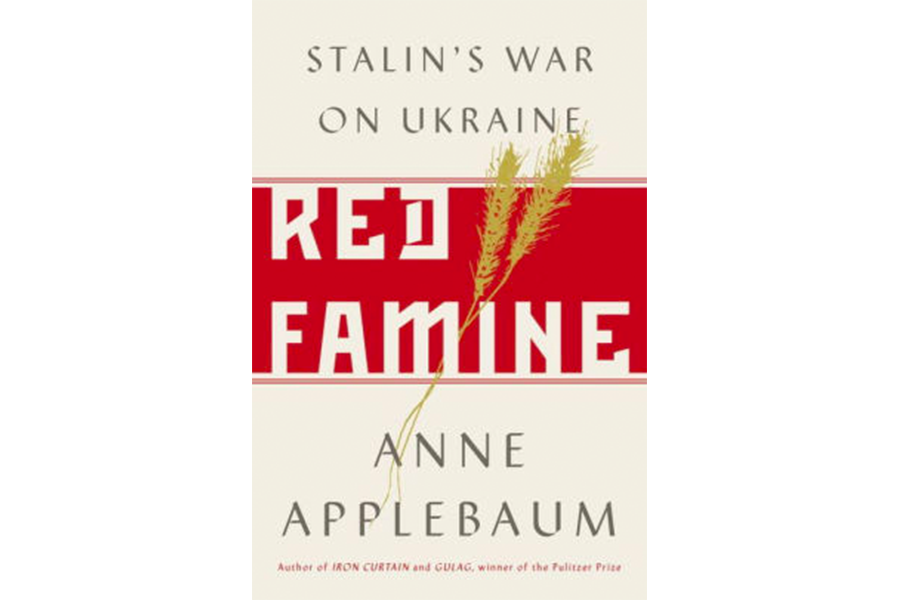'Red Famine' chronicles the ruin wrought upon Ukraine by Joseph Stalin
Loading...
The appropriately ominous term for the subject of Anne Applebaum's new book Red Famine is holodomor. It's “a term derived from the Ukrainian words for hunger – holod – and extermination – mor,” and it's also a description of the horrifying events that took place in Ukraine between 1932 and 1933, when state-mandated famine stalked every city and town in the country and the state's agents were often spurred by their own hunger. “At the height of the crisis,” Applebaum writes, “organized teams of policemen and party activists, motivated by hunger, fear, and a decade of hateful and conspiratorial rhetoric, entered peasant households and took everything edible: potatoes, beets, squash, beans, peas, anything in the oven and anything in the cupboard, farm animals and pets.”
Applebaum, Pulitzer Prize-winning author of "Gulag," here chronicles in almost unbearably intimate detail the ruin wrought upon Ukraine by Josef Stalin and the Soviet state apparatus he had built on suspicion, paranoia, and fear. The seeds of the disaster were sown when Stalin collectivized the vast farmlands of Ukraine in 1929, systematically ending not only local farming autonomy but all aspects of local autonomy, from village government to inheritance laws. Farmers were no longer paid in money for their produce but with trudoni, a ration system allegedly based on productivity but in reality an all-purpose tool of manipulation. “Theoretically, the system was supposed to provide an incentive to work,” Applebaum writes. “In practice, it also meant that peasants had no cash, no way to purchase food, and no mobility.”
At least 5 million people died of starvation in the Soviet Union between 1931 and 1934, and 3.9 million of those deaths happened in Ukraine. Raphael Lemkin, creator of the term “genocide” (and subject of Philippe Sands' excellent 2016 book "East West Street"), referred to what happened in Ukraine as “a classic example,” because in addition to a state-mandated plan of systematic starvation, “anyone who had promoted the Ukrainian language or Ukrainian history, anyone with an independent literary or artistic career, was liable to be publicly vilified, jailed, sent to a labour camp or executed.”
Readers of Applebaum's earlier books, including both "Gulag" and "Iron Curtain," will know to expect her pointedly effective alternating between large-scale history and personal stories, and they won't be disappointed. In "Red Famine," she makes use of government reports, letters, and even a generous amount of poetry in order to convey the human dimensions of this catastrophe. In the spring of 1932, when it was finally unavoidably obvious that “many, many people were going to starve,” letters flooded in to Moscow from villagers and farmers who saw their own deaths in the oncoming winter. “Dear Stalin,” one letter read, “Please answer me, why are the collective farmers on the collective farms swelling with hunger and eating dead horses?” Villages became ghost towns; fields were uncultivated because their farmers were too weak to work; corpses lay unburied in streets and country lanes. Family members robbed cemeteries, digging up corpses in order to retrieve any valuables and sell them for whatever food they could get. Things became so bad that even Stalin's party officials, fearful as ever of his unpredictable, homicidal anger, were sometimes prompted by their conscience to speak up. “Peeking through the lace curtains of their well-appointed trains,” Applebaum writes, “many senior Bolsheviks saw things that summer that horrified them, and a few of them were brave enough to tell their leader about it."
Even in the autumn of 1932, things could still have been salvaged. The state could have distributed grain, halted its extortionate grain export quotas, even sought help from abroad, as it had in the Ukrainian famine of 1921. Instead, Stalin intensified his oppression. In fact, the only actor in Applebaum's saga who absolutely refuses humanization is Stalin himself. He is throughout a soulless monster, the ultimate source of almost incalculable misery and death. Even the small aid he eventually gave to starving Ukraine he gave grudgingly, out of every dictator's fear of popular uprisings.
That aid – lessening of quotas, reduced by still desperately-needed harvests – slowly eased the crisis, although as Applebaum points out, life never really goes back to “normal” after a disaster on the scale of the Holodomor. Families, farms, and entire villages were destroyed, and as our author points out, the devastation can still be seen even now, nearly a century later, “in the wide fields that once belonged to collective farms, in the overgrown cemeteries, and in the monuments put up since the dissolution of the Soviet Union.”
The story of the Ukraine famine has been related in popular histories many times in English, perhaps most notably Robert Conquest's 1986 book "The Harvest of Sorrow." Applebaum gives a chorus of contemporary voices to the tale, and her book is written in the light of later history, with the fate of Ukraine once again in the international spotlight and Ukrainians realizing with newly-relevant intensity that, as "Red Famine" reminds us, “History offers hope as well as tragedy.”






